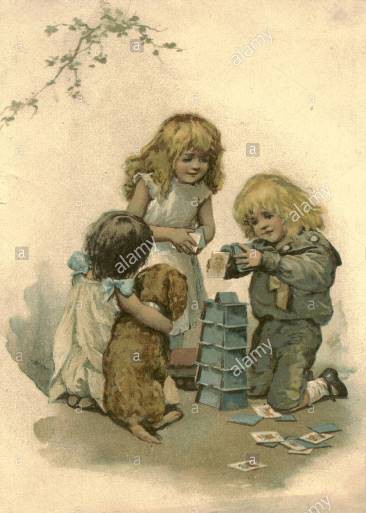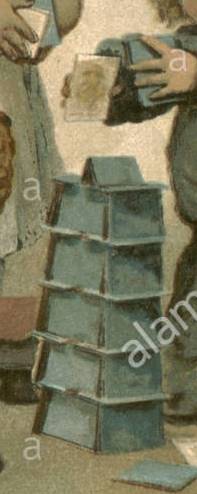| The Public Paperfolding History Project
Last updated 19/3/2024 x |
|||||||
| Card Castles / Houses of Cards / Chateaux de Cartes / Playing Card Skittles | |||||||
| This
page attempts to record what is known about the origin
and history of playing cards used to build Card Castles /
Houses of Cards / Chateau de Cartes and to play Skittles.
Please contact me if you know any of this information is
incorrect or if you have any other information that
should be added. Thank you. Playing cards which have been folded in half lengthwise appear in a number of paintings / prints / caricatures from the 18th and 19th Centuries. Some of these are clearly being used to build Card Castles, using the Tower method (see below), while others appear to be being arranged to be used for the game of skittles, in the way that Playing Card Monks often were. In other instances there is simply insufficient context to know what the folded cards are intended to be used for. Because these cannot be assigned to a specific individual page I have included them here on a pro tem basis. Hopefully, further information will emerge. There appear to be four types of card castle, two of which use unfolded and two folded cards. For the sake of being able to refer to them easily I will call the methods using unfolded cards the Tower and Pyramid methods and those using folded cards the Column and Cube methods. The construction of card castles from unfolded cards may have been a stepping stone towards a more general use of folded (and sometimes also cut) playing cards as children's toys. A more generalised index page about designs made by folding playing cards can be found here. ********** Undated This image is undated but said to be from the 19th Century. It is possibly an illustration taken from a book. The drawing is signed but I cannot identify the artist. I have included it here because it is the clearest image I know of showing folded playing cards used as skittles. If anyone can help date this picture I will be most grateful.
********** 1606 The first mention of Chateaux de Cartes that I am aware of appears in the entry for 6th October 1606 in the journal of Jean Heroard who was the personal doctor of the young Louis XIII. This journal was published in two parts in 1868 under the title 'Journal de Jean Heroard sur l'enfance et la jeunesse de Louis XIII'. Information from Michel Grand.
The relevant part of the entry reads 'il s'amuse a faire des chateaux de cartes', in English 'he amused himself making card castles'. There is no indication of which method of building a card castle was being used. ********** 1646 Mention of a house of cards appears in 'Three Tractates' by Joseph Hall, which was published in 1646.
********** 1725 This engraving by Francois Joullain after Charles Antoine Coypel shows a child building a Card Castle using the Tower method, although the construction method does not seem to be accurately represented. A card at the lower left bears the words 'Car Coypel 1725', thus giving us the date of the original painting, which appears to have been lost. Several later painted versions and at least one other print are in existence. The design in the foreground made by combining two folded cards is the Voiture de Cartes.
********** 1730 This painting by William Hogarth, which can be dated to 1730, shows a group of children with a Card Castle built using the Pyramid method.
********** c1735/7 This painting by Jean-Baptiste Simeon Chardin (1699 - 1779), which can be dated to c1735/7, shows a boy playing with folded playing cards. From the way the cards are arranged it seems as though they may be being set out for a game of skittles but according to the title of the print by Pierre Alexandre Aveline they are being set out as the foundation for a Chateau de Cartes.
********** This second painting, also by Jean-Baptiste Simeon Chardin (1699 - 1779), and also dated to c1735/7, shows a boy building a house of cards using the Tower method, but also shows several folded cards standing nearby on the table.
********** c1738 This third picture by Jean-Baptiste Simeon Chardin, titled 'La Gouvernante' (The Governess), held in the collection of Tatton Park in Cheshire, and which can be dated to c1738, shows two folded playing cards standing / lying on the floor.
********** c1740 Also in about 1740 the studio of the British painter Francis Hayman produced a painting, designed by Hubert Francois Gravelot, titled 'Building Houses of Cards' which was hung in a supper-box at Vauxhall Gardens. In 1743 a print of the design was made by Gravelot / Lauren Truchy. The adults are building a card castle using the Tower method. The children on the smaller table are either building a second card castle using the simpler Column method or playing a game of skittles.. From http://www.historicalportraits.com/Gallery.asp?Page=Item&ItemID=520&Desc=Card-party-%7C-Hubert-Francois-Gravelot: 'In about 1740 the then proprietor of the Gardens Jonathan Tyers decided, in the face of competition from the Rotunda at Ranelagh Gardens (later made famous by Canaletto), that displaying works of art could help him attract more visitors. The decision was an astounding success, not least because it was effectively England’s first public art gallery. In each of the supper-boxes Tyers hung a painted scene, or ‘conversation piece’, with the latest designs by artists such as Hogarth, Hayman, and Gravelot. Almost all the pictures were painted in the studio of Francis Hayman, a leading artist of the day whose pupils included the young Gainsborough. Professor Allen has shown in his article ‘Francis Hayman and the Supper Box Paintings for Vauxhall Gardens’ [in The Rococo in England, London 1986], that most of the supper-box pictures for Vauxhall were produced in a short period of time in the early 1740s. We know from the letter-press of early engravings that Gravelot was responsible for a number of designs, which are immediately distinguishable in the Vauxhall series by the elegance of the composition and the obviously French fashion and interiors. Those now known to be by Gravelot are; The House of Cards, the Mock Doctor, and Quadrille.'
********** 1744 This engraving from 1744 shows a young woman building a house of cards from folded playing cards using the Column method. The print was made by Jean Michel Liotard after Francois Boucher and comes from the collection of the British Museum.
********** Undated Miniature In this undated miniature, said to be French School, 18th Century, the Card Castle seems to have been based on the one on the Francois Boucher painting and therefore may be of similar date.
********** 1745 This painting by the Flemish painter Joseph Francis Nollekens (1702–1748) which shows two children, probably the painter's son and daughter building a Card Castle, rather unsuccessfully, can be dated to 1745.
********** 1749 Several folded playing cards are pictured in a painting of Louis-Philippe-Joseph duc de Montpensier, later the duc d’Orléans by François Boucher (1703 to 1770), which is in the collection of Waddesdon Manor (acc. no. 481) and which can be dated to 1749. The painting also includes la Voiture de Cartes.
********** c1750 This painting by Johann Anton de Peters (1725 to 1795), which can be dated to around 1750, shows two boys building a card castle using the Tower method.
********** 1759 This lottery card showing a girl building a Card Castle, using a mixture of methods, comes from the 'Almanach utile et agréable de la loterie de l’Ecole Royale Militaire' published in Amsterdam & Paris in 1759 by Prault Pere and Laurent-Fr. Le Clerc. The engraving is by Hubert François Gravelot (1699-1773).
********** This print by Jean Baptiste Pillement, published on 26th Dec 1759, shows Chinese children building a House of Cards. It seems to be a Playing Card Cube augmented with a roof made from two other cards. This is a good example of a Western European design being orientalised.. ********** 1772 This book illustration is taken from C.F. Gellert's 'Fabelen en Vertelsels' (Fables and Tales), published in 1772. It shows a Kaartenhuis, the lower levels of which appear to be made of cubes whose faces are cards cut or folded down to squares. This strongly suggests that it may be made of seven Playing Card Cubes. There are, however, no flaps in view (as there would be with Playing Card Cubes) and all the cards seem to be arranged in the same direction. The construction of the roof also seems suspect. However, the child in the picture is clearly about to push the structure over and the poem that accompanies the illustration in the book makes reference to the house being destroyed and rebuilt repeatedly, which would not be possible if the cards were glued together. On balance, therefore, it is likely that this is intended to be a representation of a Card Castle built using Playing Card Cubes, although a representation that was probably drawn from memory / imagination rather than from life.
********** 1775 or earlier This painting by the French painter François Hubert Drouais (1727–1775) also shows a boy building a Card Castle, but using no particular method. The picture also includes a Playing Card Monk (and probably another lying inside the top layer of the card castle). I do not know when this picture was painted but it can be no later than 1775 when the painter died.
********** This second painting by François Hubert Drouais also shows children building a Card Castle, this time clearly using the Tower method.
********** 1776 or earlier This engraving showing a child building a card castle using the Column method was made by Gilles Demarteau (1729? to 1776). I do not know the date of this engraving but it can be no later than 1776 when the engraver died. It also appears to be based on the 1744 painting by Francois Boucher.
********** 1781 This painting by the German painter Johann Ernst Heinsius (1740–1812) shows a young boy playing with cards. The cards appear to have been folded in half and stood on end. The fact these cards have been arranged in a line suggests to me they may be being set up to be used as skittles (in the way that Playing card monks were) rather than to build a card castle.
********** 1786 This print entitled 'An Ordinance Dream or Planning of Fortifications' was published on March 7th 1786. It shows a House of Cards built using the Pyramid method.
********** 1793 or earlier This print by Louis-Marin Bonnet (1743-1793) after Jean-Baptiste Huet (1745 - 1811) shows children building a card castle using a mixture of methods. It cannot be dated later than 1793 when the engraver died..
********** 1795 There is mention of the young and imprisoned Louis XVII of France building playing cards into castles in 'Anecdotes relatives à quelques personnes et à plusieurs événements remarquables de la Révolution' (Anecdotes relating to some people and to several remarkable events of the Revolution) by Jean-Baptiste Harmand, published in 1814. Information from Michel Grand.
In English the relevant sections translate as: Page 16: 'In ... February 1795 the Commissaires of the Commune of Paris, who as I said in the previous anecdote, had the surveillance of the Temple and the illustrious prisoners who were locked up there, came to the Committee of General Safety, of which I was a member, (for a) report that the health of the Dauphin, who in France was called Prince Royal since the Revolution, and elsewhere King by legitimate order of succession, was threatened with imminent danger and called for urgent help.' Page 21 bottom: 'The Prince was seated near a small square table on which were scattered many playing cards; some were folded in the form of a box and a crate, others built into castles; he was busy with these cards when we entered, and he did not quit his game.' The words 'pliees en forme de boite et de caisse' suggest that the Prince had been making Playing Card Cubes. The method he had used to build card castles cannot, unfortunately, be inferred from the text. ********** 1806 or earlier This painting by the French painter Jean-Baptiste Charpentier the Elder (1728–1806) shows a young girl building a Card Castle using the Tower method. The painting cannot be later than 1806 when the painter died.
********** 1827 'Manuel Complet des Jeux de Société' by Elisabeth Celnart (a pseudonym of Elisabeth Félicie Bayle-Mouillard née Canard), which was published by La Librairie Encyclopedique de Roret in Paris in 1827 includes instructions for making two types of card castle, using the Tower (Les Chateaux de briques - built on the ground, in the courtyard) and Pyramid (Les Chateaux de cartes - built on a table) methods.
The last part of the text reads, roughly, 'Once the castle is complete we can build an enclosure around it by planting cards one beside another. Here and there we can put a building, a stable etc. Little boys arrange their cards to represent an encampment, and little girls a village. Both amuse themselves well, but a sudden movement, or the slightest wind, immediately destroys these pretty buildings'. There is no suggestion that these extra cards were folded. ********** 1832 This drawing 'Armes du Grand Poulot' from 'La Caricature', No 63 of 12 January 1832 includes not only a Cocotte and a Newspaper Hat but also a number of playing cards folded, or at least bent, in half, which appear to have bayonets protruding from them.
The publication of this drawing, along with an article and another drawing from the same issue, was the basis of a prosecution brought against the editor of La Caricature, Charles Philipon. Full details are here. ********** 1843 This painting by the Austrian painter E Ritter is said to date from 1843.
********** 1844 This painting by the Polish painter Jan Maskowski is said to date from 1844. It is held in the National Museum in Wroclaw
********** 1850 This print by Theodore Valerio, titled 'Le Chateau de Cartes', and said to date from 1850, shows children building a card castle using the Pyramid method. It also includes two tiny Cocottes in the lower left hand corner.
********** c1850 This painting attributed to Thomas Frye is held in the collection of the Met Museum and said to have been painted in the mid 18th Century. It shows a girl laying cards out on a table, possibly as a prelude to building a Card Castle.
********** 1860 This print by Charles Bargue after Auguste Toulmouche shows (probably) a governess building a card castle using the Tower Method, while the children look on, the older one somewhat bored. It is in the collection of the British Museum and can be dated to 1860. There are also a number of folded Cocottes on the table, one of which has fallen on its side.
********** 1865 This picture by the French painter Charles Chaplin can be dated to 1865. It shows a child building a Card Castle using the Tower method.
********** 1869 This painting by the Belgian painter Theodore Gerard (1829 - 1895) shows a House of Cards built from folded cards using the Column method.
********** c1880 This print, said to be c1880, shows children building a card castle using the Tower method.
********** |
|||||||
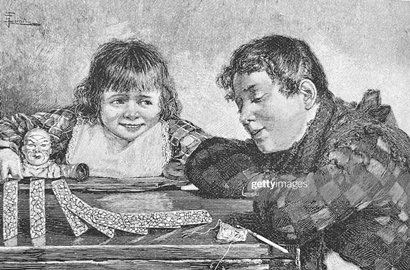
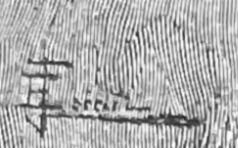
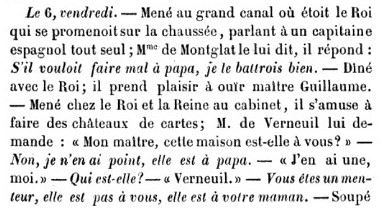
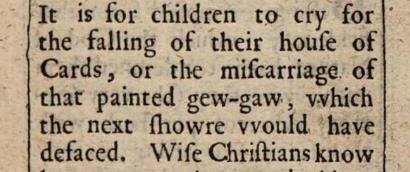
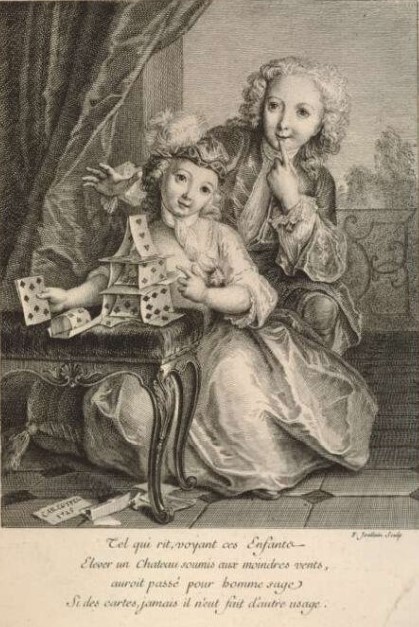
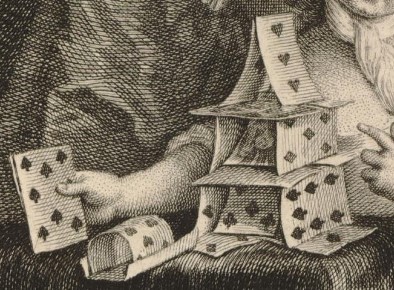
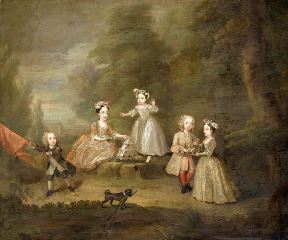
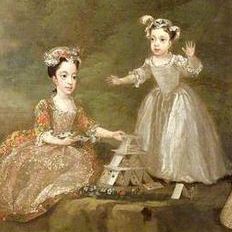

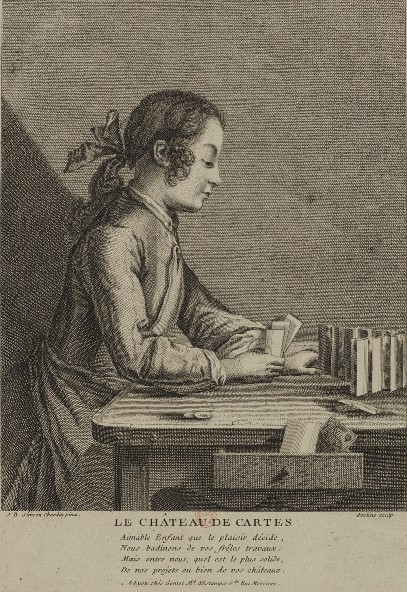
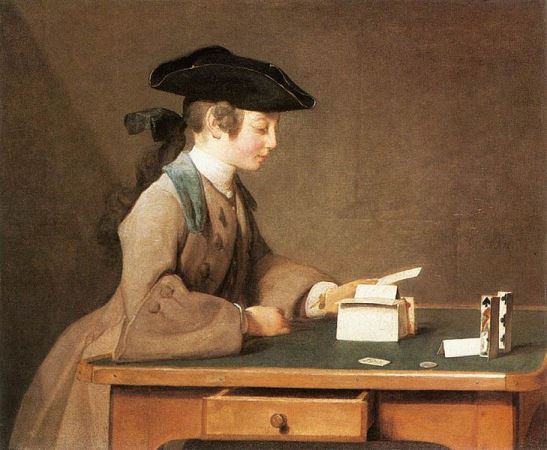
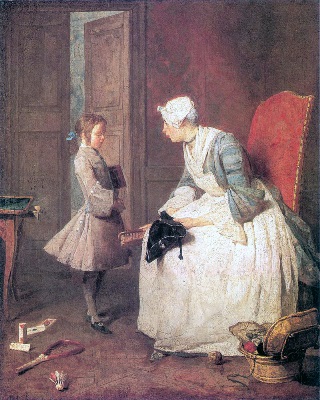
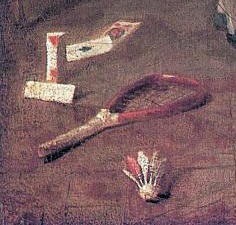
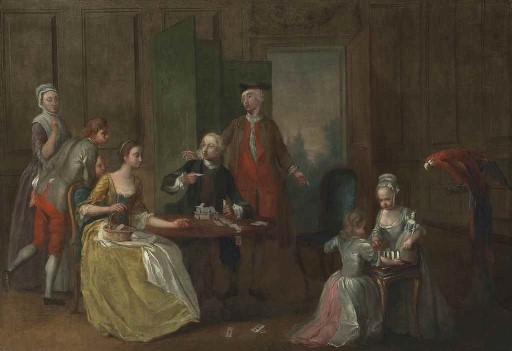
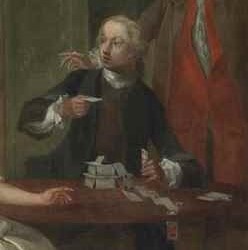
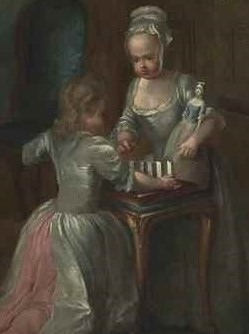
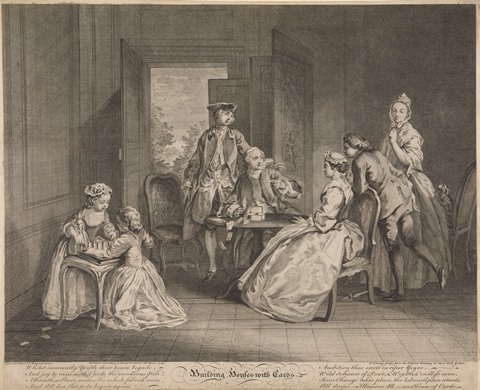
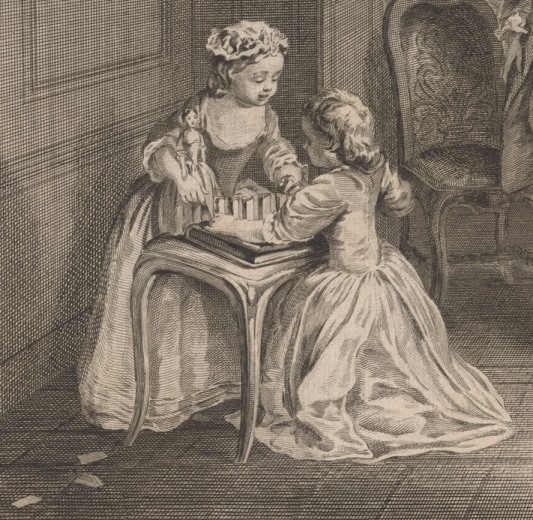
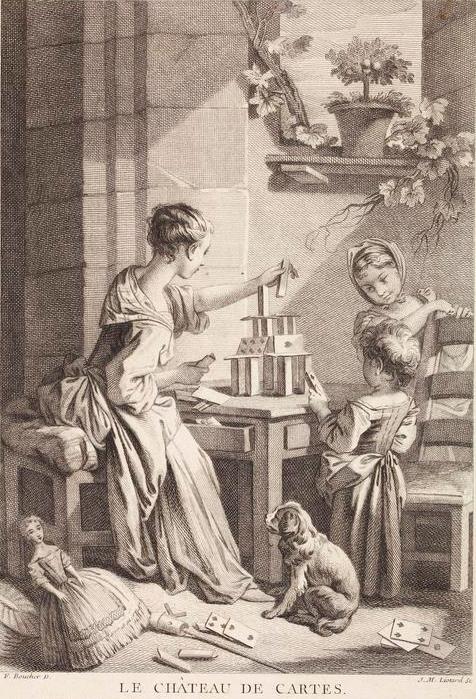
%20Miniature%20a.jpg)
%20Miniature%20b.jpg)
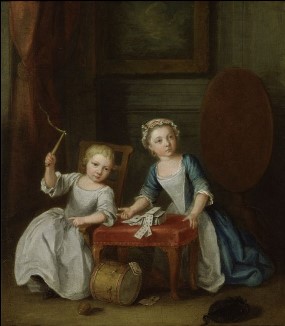
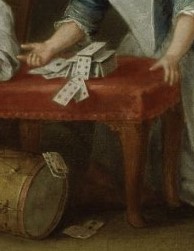


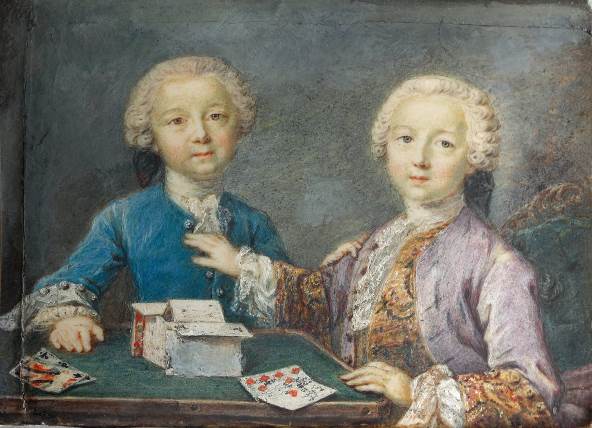
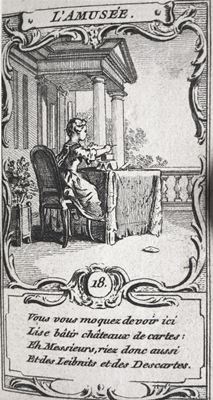
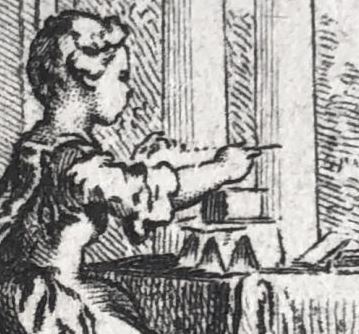
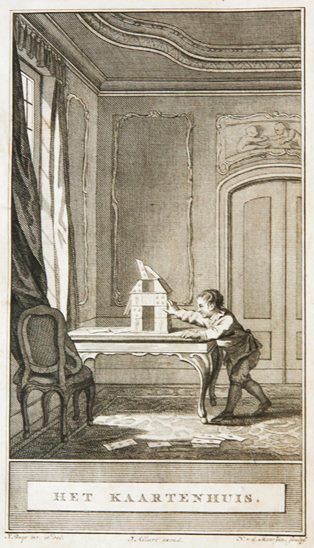
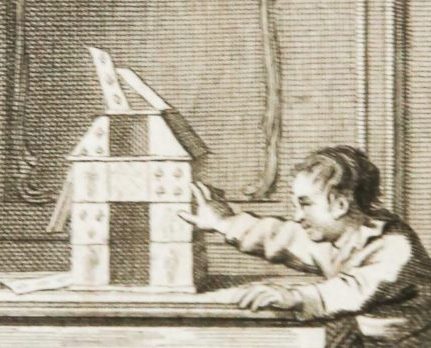

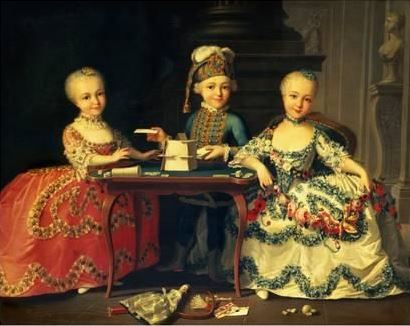
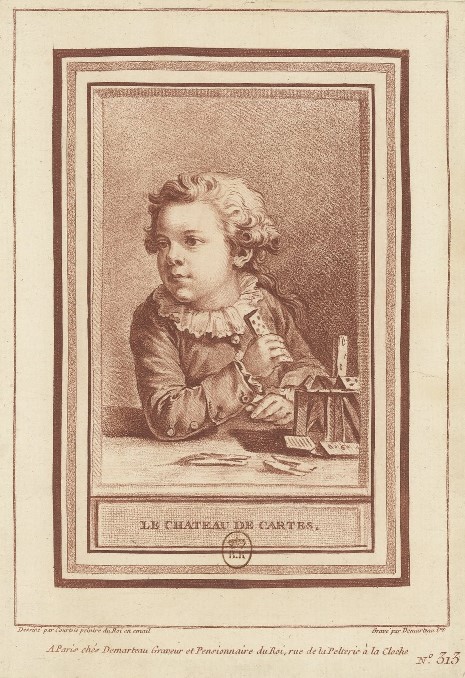
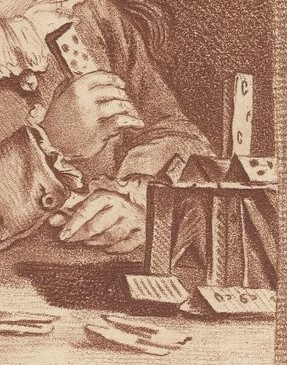
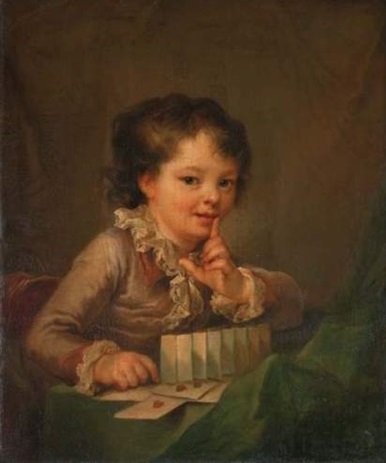
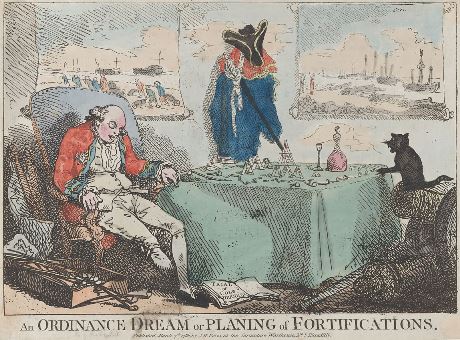
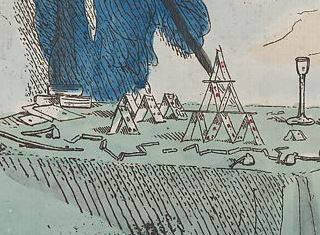
%20d'après%20Jean-Baptiste%20HUET%20a.jpg)
%20d'après%20Jean-Baptiste%20HUET%20b.jpg)
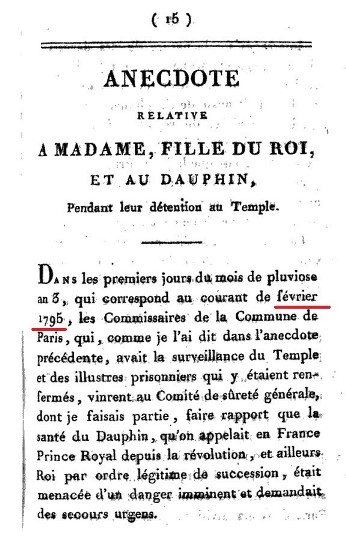
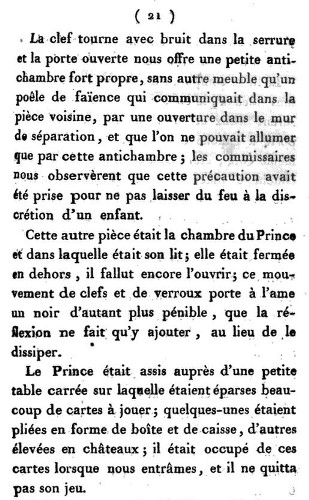
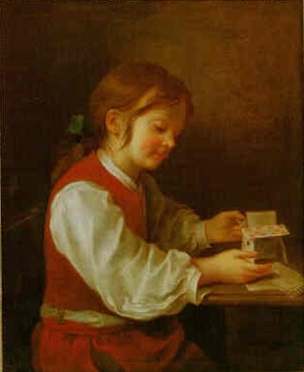
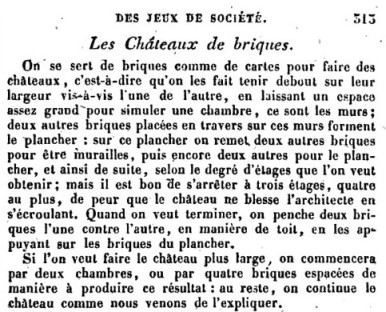
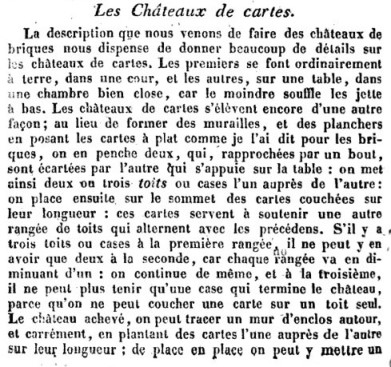

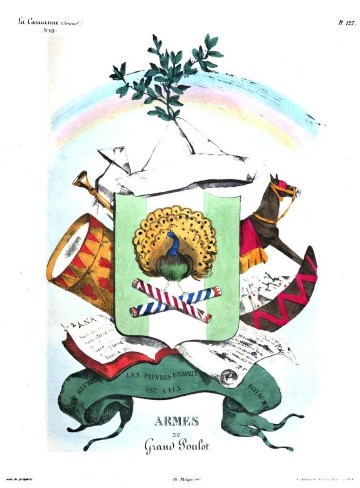
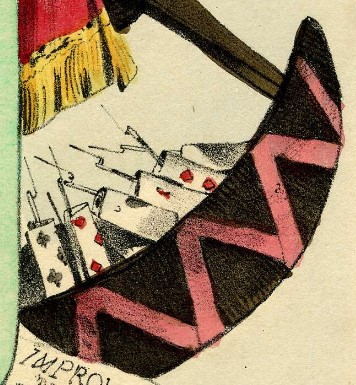
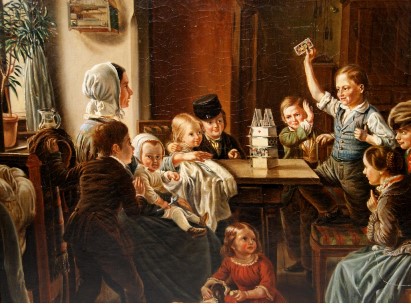
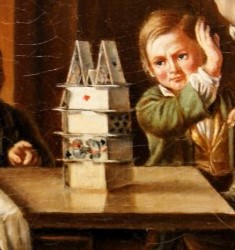
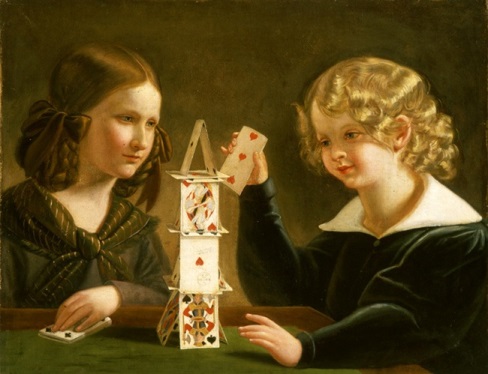
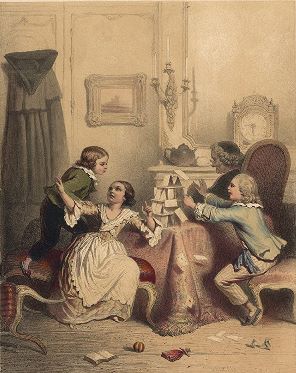
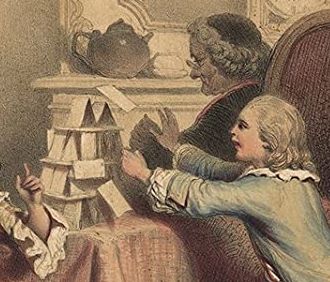
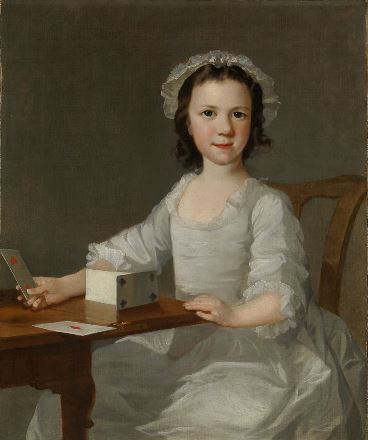
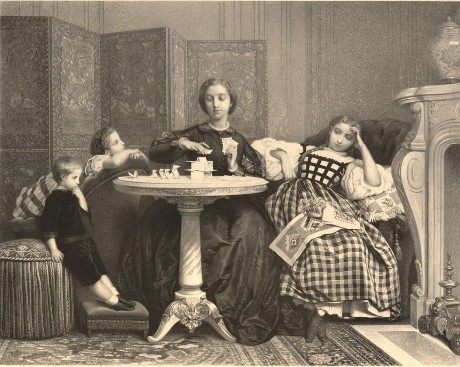
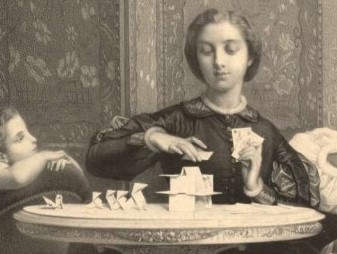
,%20_Le%20Chateau%20De%20Cartes%20a.jpg)
,%20_Le%20Chateau%20De%20Cartes%20b.jpg)


